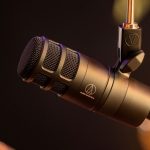The key difference between a large and small diaphragm condenser is the size of its diaphragm. Large diaphragm condenser mics usually have a diaphragm capsule diameter exceeding 1 inch, while small diaphragm mics have a diaphragm size of around 0.5-0.65 inches.
One advantage of large diaphragm mics is that larger diaphragms are generally easier to move and more sensitive to sound, resulting in a louder output signal. Small diaphragm mics, by contrast, are better at capturing transients and higher frequency sounds – they tend to sound more “natural” and “airy” and often have less coloration than large diaphragm condensers.

Differences in Pickup
Since large diaphragm mics do a better job of capturing the depth of low frequency sounds, they tend to be used on recordings where a certain amount of coloration is desired. This makes them ideal for recording vocals, guitar or bass amps, where a certain amount of warmth in the sound can make the sound feel “bigger” and “larger than life”. This makes the sound feel more “pleasing” – particularly when it comes to recording vocals.
Small diaphragm mics, by contrast, are be used to capture high-frequency sounds and transients. They work best when used to capture the natural sound of instruments (such as wind instruments, piano and strings). They tend to have a bit more “air” to their sound and less coloration than a large diaphragm condenser, making them a recording engineer’s favorite choice to capture the sound exactly as it sounds. Because a small diaphragm condenser diaphragm has lower mass, this allows it to follow movements in the air more easily and provide greater sensitivity. Small diaphragm mics tend to be more rigid overall, and can prevent distortion even at high volume levels.
Sound Differences
If you are recording vocals at home, the best option would generally be for a large diaphragm condenser mic. This is because a large diaphragm condenser can add a certain warmth and coloration to your vocals that make it sound “bigger” and “larger than life”, shaping your voice in a pleasing way. A large diaphragm condenser can bring out the natural tones in your voice and sounds exactly like you.
One key consideration is that large diaphragm condensers are usually side-address mics, which are better positioned for singing into when recording in a studio or on stage. This also gives the singer something to focus on when recording, instead of a small diaphragm condenser which must be angled towards the source.
In addition to vocals, large diaphragm condensers are great for recording solo instruments to make them sound vibrant and rich, and capture the warmth of the instrument.
By contrast, small diaphragm condensers work best if you want to capture pure and natural sound without any added coloration. This is great if you want detailed uncolored sound (i.e., completely neutral sound) to capture the clarity and detail of each individual instrument. For example, small diaphragm condensers work great for strings, piano and wind instruments, as well as drums and percussion. Although small diaphragm mics can also be used for bass instruments, a large diaphragm mic can provide an added boost to the sound signature which can be desirable.
However, if you are recording solo at home, we highly recommend starting out with a large diaphragm condenser to bring out the lushness in your voice and warmth of your instruments.
Noise Levels
Technically speaking, a large diaphragm condenser has better noise performance than a small diaphragm condenser. Because a large diaphragm mic requires more energy to move, it has generally lower self-noise than a small-diaphragm condenser. While a low self-noise is barely noticeable when recording relatively quiet instruments, smaller diaphragm condensers have the tendency to reach a noise level that may be clearly audible if not closely monitored.
With that said, small diaphragm condensers have a few technical advantages, such as excellent transient response, extended high-frequency range and consistent pickup pattern. Some sound engineers prefer to work exclusively with small diaphragm mics due to their consistent pickup when recording instruments, choir or piano.
Large vs small condenser – which mic should you get?
If you plan on recording at home, we recommend going for a large diaphragm condenser mic. A large diaphragm condenser mic is best for bringing out the subtleties in your voice, and make it feel larger and “bigger”. It also adds a natural warm coloration to your voice, making it sound natural and exactly how you would want your voice to be heard on a recording.
For this reason, most musicians usually start out with a large diaphragm condenser mic when recording at home. Acoustic guitar and guitars also sound very articulate on large diaphragm condensers, giving them a nice sparkle and natural coloration.
With that said, if you are recording in a band and record a lot of instruments (i.e., piano, wind instruments and drums including cymbals), a small diaphragm condenser provides added clarity and extended high-frequency ranges that a large diaphragm mic may not capture. They also have a consistent pick-up pattern, which makes them ideal for use in sound engineering.
Classic examples of large diaphragm condenser mics
- Neumann TLM-102 Large Diaphragm Condenser
- LEWEITT LCT 540 Large Diaphragm Condenser
- Steller X2 Large Diaphragm Condenser
Classic examples of small diaphragm condenser mics
- Neumann KM 184 Small Diaphragm Condenser
- Audio-Technica Pro 37 Small Diaphragm Condenser
- AKG C 451 B Reference Small Diaphragm Condenser
Next Steps
If you are interested in learning more about how to set up your home recording studio, or want to learn more about the different types of mics in general, be sure to check out these articles below:



